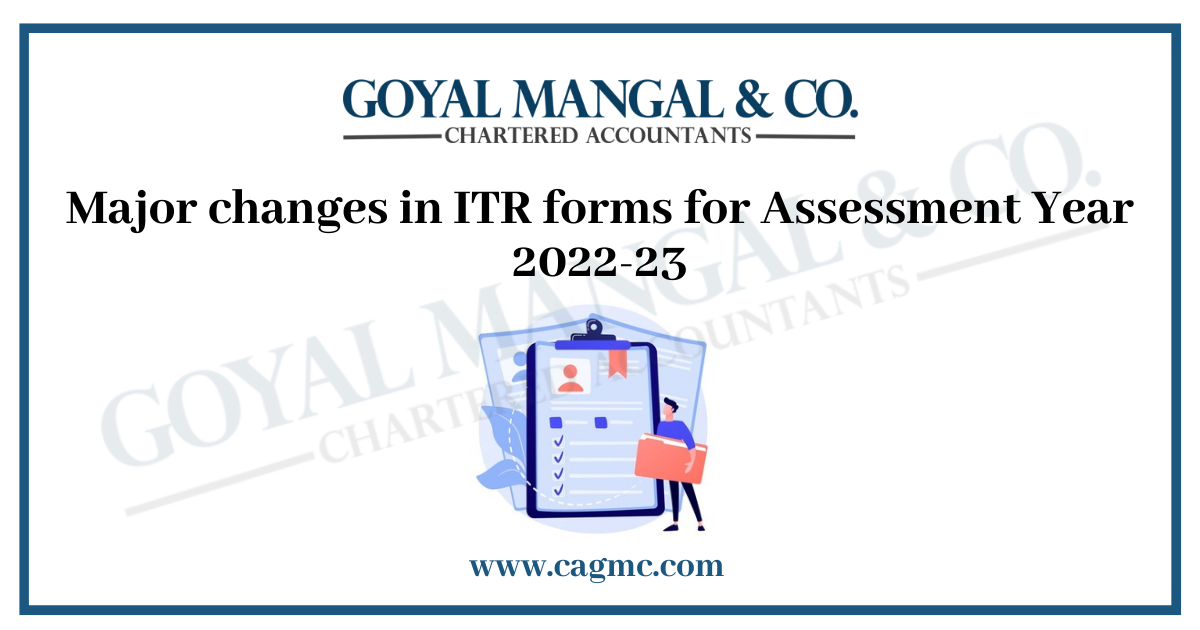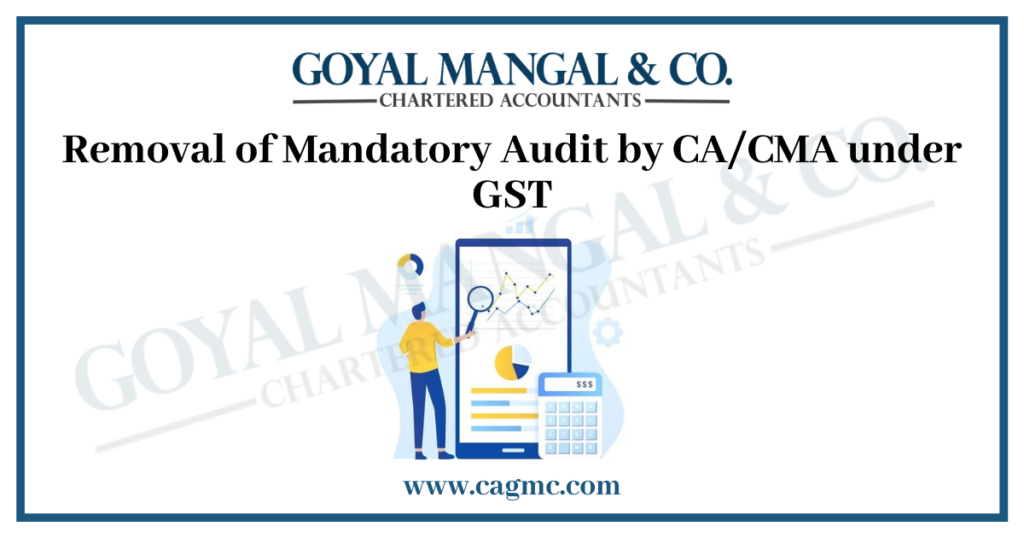
Last month the income tax department informed us about the income tax return (ITR) forms for FY 2021-22 or AY 2022-23. Although no key changes are declared, there are still some revisions in the forms that every taxpayer must be aware of while filing ITR. This blog will deal with major changes in ITR forms for FY 2022-23.
|
Table of Content |
What is ITR form?
There is a total of seven ITR forms. ITR (Income Tax Return) is a form that an individual or business has to submit to the Income Tax Department of India. Further, it comprises information about the individual’s income and the taxes he/she has to pay on it during the year.
Changes in the ITR for Assessment Year 2022-23 in general
Some of the changes in the ITR Forms for AY 2022-23 are:
Category of Pensioners
The following options are for pensioners in new ITR forms: Pensioners – CG, Pensioners – SC, Pensioners – PSU and Pensioners – others.
Reporting of Interest Income from EPF
Earlier if an employee contribution increases more than Rs.2,50,000 a financial year, then interest added on such additional contribution was taxable as an “Income from Other Sources”. But, know they have to announce such interest income on yearly basis and pay the tax.
The limit of Rs. 2,50,000 will rise to Rs. 5,00,000 if such a person has contributed to a fund where there is no contribution by the employer. Further, the Schedule OS (Other Sources) is amended to incorporate the reporting necessities of such interest income from EPF contributions as per the new rule ITR form.
Reporting of foreign assets
Now the ITR Forms, except ITR 1 and ITR 4 require resident taxpayers to reveal their foreign assets. For example, assets like shares (ESOPs, RSUs), and property under Schedule FA.
The reporting of conditions is only compulsory for the taxpayers residing in India. Non-residents do not have to file under schedule FA. Various foreign assets like Foreign Depository Account, Immovable Property, trusts created abroad, etc. must be disclosed under this schedule FA.
Additional disclosure in case of Capital Gains
The following additional disclosures in the Schedule CG (Capital Gains) both Long and Short are necessary in new ITR forms:
- Purchase and sale date of land or building
- The Counties name and Zip Code if the property is foreign
- Yearly details of the cost of enhancement to land or building
- Separate disclosure of the cost of acquirement and indexed cost of acquirement
Residential status in India ITR
The benefits given to NRIs and income tax rules are different from rules applicable to resident Indians. The NRIs file returns in ITR-2 in all cases, excluding business income. NRIs with business income file returns in ITR-3. The taxability of tax from NRIs depends upon their residential status.
NRIs Income earned and are taxable income in India can be:
- Salary earned in India
- Salary for service given in India
- Income from the property in India like Rental
- Capital gains on transfer of Indian assets like sale of property etc.
- Income from FD (Fixed Deposits)
- Interest on the savings account
New tax regime determined under Section 115BAC
During FY 2021-22 only information essential was if one has opted for the new tax regime or not. Conversely, for the FY 2022-23, one has to choose from the following options:
- Opting in now
- Not opting
- Continue to opt
- Opt-out
Reporting of tax-deferred on ESOP
The New ITR Forms have introduced a “Schedule: Tax-Deferred on ESOP”. The Schedule tries to find the following disclosures:
- The amount of tax-deferred in ITR filed for AY 2021-22
- Date on which the person ceased to be an employee of the organization
- The amount of tax payable in the current assessment year;
- Date of sale of specified securities and amount of tax attributable to such sale
- Balance amount of tax-deferred to be carried forward to next assessment years
The new Schedule track the sum of tax-deferred by the employee and the year it should be taxed. Further, the tax payable in the current assessment year is transferred in a new row introduced in Schedule Part B – TTI (Computation of tax liability on total income)
Relief under Sec.89A from taxation of income from retirement benefits account maintained in notified countries
Section 89A is introduced from the assessment year 2022-23. It has removed the earlier difficulty by providing that the income of a definite person from the definite account shall be taxed in such manner and for such year as may be prescribed by rules. The rules have not been yet informed by the board.
Still, the new ITR Forms have amended Schedule S which talks about Details of Income from Salary to be disclosed. It is necessary to disclose the following details:
- The Income from the retirement benefits account is maintained in a notified country under Section 89A.
- The Income from the retirement benefits account is maintained in a country other than notified country under Section 89A.
In respect of family pension similar disclosure has to be made in the Schedule OS (Income from Other Sources).
Major changes in ITR forms for AY 2022-23
Following are some of the major changes in ITR form for AY 2022-23:
Changes in ITR-1 for AY 2022-23
Under this form, it is necessary to provide information about income from overseas retirement funds while calculating their net salary.
Changes in ITR-2 for AY 2022-23
The following are the changes in ITR-2 for AY 2022-23:
- The assesses have to provide information about income from overseas retirement funds while calculating their net salary.
- The details such as the amount of tax-deferred in earlier AY, date of specified securities, date of employment ceased, amount of tax payable in current AY, Balance amount of tax-deferred c/f in next AY, etc. should be as per the new section introduced for reporting of the tax-deferred on ESOP received from employer being an eligible start-up under 80IC.
- Separate disclosure is necessary for interest and dividend incomes taxable as per Section 115AC of bonds and GDR got in foreign currency.
- The assesses has to FMV of capital assets which are transferred by way of slum sale and fair market rate of consideration got or accumulating due to transfer by way of slum sale.
- Assesses must disclose the foreign asset details on a schedule year basis that is till December 2021, instead of financial year basis March.
Changes in ITR-3 for AY 2022-23
The following are the changes in ITR-3 for AY 2022-23:
- The assesses have to provide information about income from overseas retirement funds while calculating their net salary.
- Separate disclosure is necessary for interest and dividend incomes taxable as per Section 115AC of bonds and GDR got in foreign currency.
- The details such as the amount of tax-deferred in earlier AY, date of specified securities, date of employment ceased, amount of tax payable in current AY, Balance amount of tax-deferred c/f in next AY, etc. should be as per the new section introduced for reporting of the tax-deferred on ESOP received from employer being an eligible start-up under 80IC.
- The assesses will disclose the details of tax on secondary adjustments under section 92CE (2A) which is the number of primary adjustments on which option exercised an amount not repatriated, amount payable and challan payment.
- Assesses must disclose the foreign asset details on a schedule year basis that is till December 2021, instead of financial year basis March.
- The assesses has to FMV of capital assets which are transferred by way of slum sale and fair market rate of consideration got or accumulating due to transfer by way of slum sale.
Changes in ITR-4 for AY 2022-23
The following are the changes in ITR-4 for AY 2022-23:
- The assesses have to provide information about income from overseas retirement funds while calculating their net salary.
- The assesses will disclose the Aggregate of payments arising from the transaction or transactions during the previous year as referred to in Explanation 2A(a) of section 9(1)(i) of the Information Technology Act, 2000 and the number of users in India as referred in Explanation 2A(b) Section 9(1)(i) of the IT Act. But this disclosure will only be if a non-resident person has Special Economic Presence in India.
Changes in ITR-5 for AY 2022-23
The following are the changes in ITR-5 for AY 2022-23:
- Separate disclosure is necessary for interest and dividend incomes taxable as per Section 115AC of bonds and GDR got in foreign currency.
- The assesses will disclose the Aggregate of payments arising from the transaction or transactions during the previous year as referred to in Explanation 2A(a) of section 9(1)(i) of the Information Technology Act, 2000 and the number of users in India as referred in Explanation 2A(b) Section 9(1)(i) of the IT Act. But this disclosure will only be if a non-resident person has Special Economic Presence in India.
- Assesses must disclose the foreign asset details on a schedule year basis that is till December 2021, instead of a financial year basis of March.
- The assesses has to FMV of capital assets which are transferred by way of slum sale and fair market rate of consideration got or accumulating due to transfer by way of slum sale.
- The assesses will disclose the details of tax on secondary adjustments under section 92CE (2A) which is the number of primary adjustments on which option exercised an amount not repatriated, amount payable and challan payment.
Changes in ITR-6 for AY 2022-23
The following are the changes in ITR-6 for AY 2022-23:
- Separate disclosure is necessary for interest and dividend incomes taxable as per Section 115AC of bonds and GDR got in foreign currency.
- The assesses will disclose the Aggregate of payments arising from the transaction or transactions during the previous year as referred to in Explanation 2A(a) of section 9(1)(i) of the Information Technology Act, 2000 and the number of users in India as referred in Explanation 2A(b) Section 9(1)(i) of the IT Act. But this disclosure will only be if a non-resident person has Special Economic Presence in India.
- Now the assesse has to disclose investment made in an unincorporated company like name of the entity, type of entity, audit liability of entity, PAN, 92E liability of entity, the share of profit in the entity, capital balance, amount of shares.
- The assesses will disclose the details of tax on secondary adjustments under section 92CE (2A) which is the number of primary adjustments on which option exercised an amount not repatriated, the amount payable and challan payment.
- The assesses has to FMV of capital assets which are transferred by way of slum sale and fair market rate of consideration got or accumulating due to transfer by way of slum sale.
- Assesses must disclose the foreign asset details on a schedule year basis that is till December 2021, instead of financial year basis March.
Changes in ITR-7 for AY 2022-23
The following are the changes in ITR-7 for AY 2022-23:
- Assesses must disclose the foreign asset details on a schedule year basis that is till December 2021, instead of financial year basis March.
- The assesses will also provide details of funds invested on the last day of the previous year.
Conclusion
Therefore, the above discussion talks about the Major changes in the ITR forms for the assessment year 2022-23. ITR comprises information about the individual’s income and the taxes he/she has to pay on it during the year.


